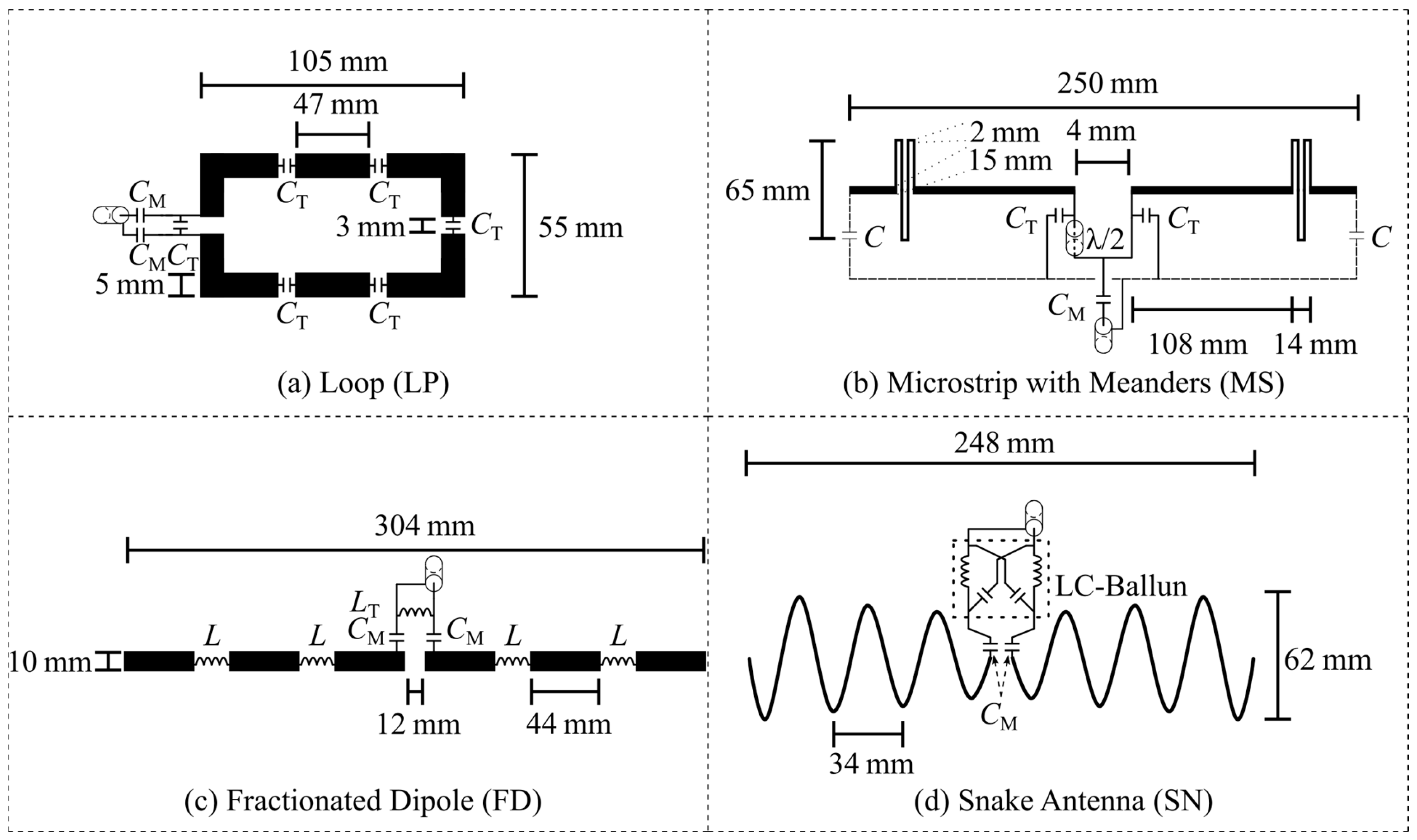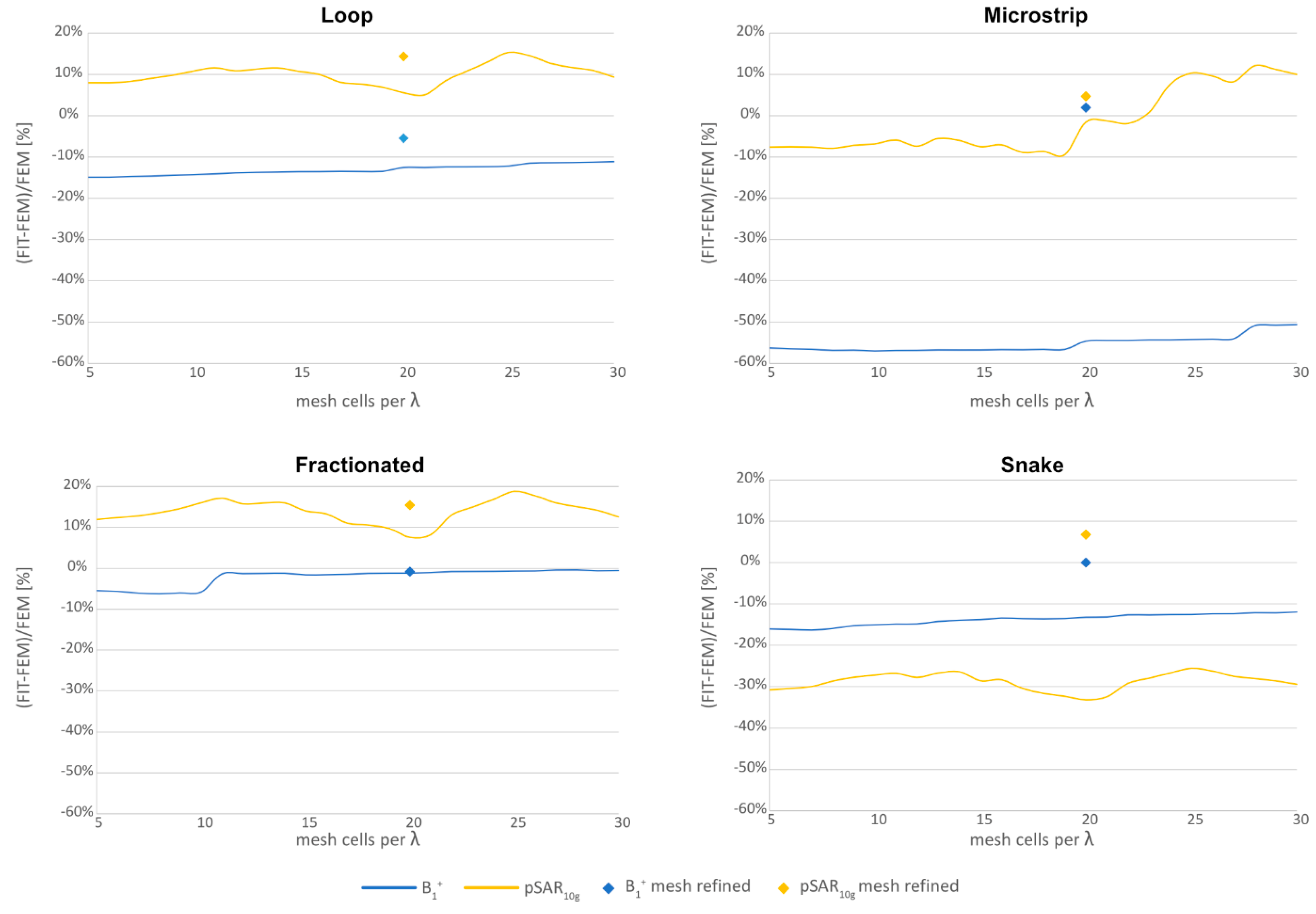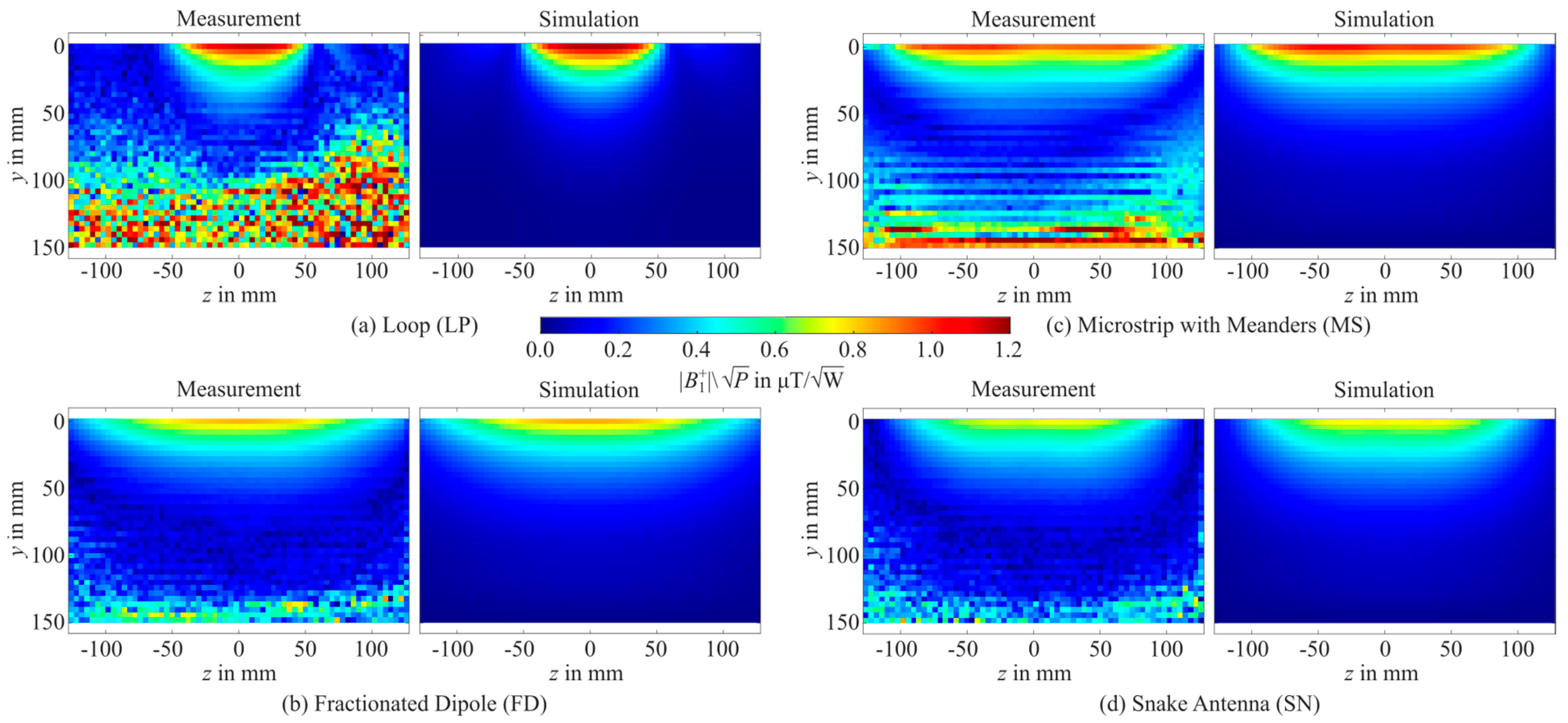1. Introduction
Magnetic resonance imaging (MRI) at 1.5 T and 3 T is a cornerstone of medical diagnostic imaging. Ultrahigh-field MRI (
B0 ≥ 7 T, UHF-MRI) provides groundbreaking opportunities for advancing biomedical and diagnostic MRI. UHF-MRI revealed more anatomical detail and pathophysiological characteristics due to enhanced sensitivity and spatial resolution [
1,
2,
3,
4,
5,
6]. This gain has served as a driving force for numerous applications in basic research and clinical science resulting in a wide range of new possibilities [
1,
2,
3,
4,
5,
6,
7,
8,
9,
10,
11,
12]. However, the opportunities of UHF-MRI are obstructed by electromagnetic field constraints including transmission field (
B1+) inhomogeneities due to wavelength (
λ) shortening and radiofrequency (RF) power deposition constraints [
12,
13].
These obstructions constrain the broader clinical application of UHF-MRI and have motivated the exploration of novel RF technologies, including local transceiver (Tx/Rx) arrays and multi-channel transmission (Tx) arrays, paired with multi-channel local receive (Rx) arrays. The RF building blocks to assemble Tx arrays can be loop, stripline, and dipole element designs including hybrid loop–dipole configurations [
14,
15,
16,
17,
18,
19]. The Tx array designs involve rigid, flexible, and lightweight configurations and are tailored to conform to the target anatomy and to accommodate multiple body habitus and anatomical variants [
16,
19,
20,
21,
22,
23,
24]. The number of RF building blocks and their density and positioning influence the Tx array design to ensure an excitation profile best suited for covering the target region [
20,
23,
25,
26,
27]. This has led to a very diverse spectrum of Tx array configurations customized for specific applications virtually ranging from head to feet [
16,
19,
20,
21,
22,
23,
24]. While the customization and diversity of Tx array designs are beneficial, they constitute challenges for validation, performance assessment, and quality assurance. Furthermore, the benchmarking of Tx elements poses a serious challenge due to the variety of specific setups and applications involved. A real-world example is provided in
Table 1, which summarizes the Tx performance reported for eight Tx element configurations customized for body UHF-MRI. These valuable reports underline the incoherence and diversity of the setups and metrics used for the assessment of Tx elements.
A critical aspect of advancing RF antenna designs is the need for reproducibility and standardization in evaluation protocols. Evaluation protocols for self-developed RF arrays typically describe internal procedures, tier-based formalities, and safety testing recommendations [
34,
35,
36]. While these efforts have contributed to the field, they lack wide dissemination, fail to represent a broad consensus, and do not consistently apply the Findable, Accessible, Interoperable, Reproducible (FAIR) principles. Reproducibility refers to the ability to obtain consistent results under varying test conditions and testers [
37]. However, reproducibility remains a significant challenge, especially for in silico modeling. In silico modeling has become a powerful tool for RF technology developments and offers substantial benefits regarding resources, time, and safety. Yet variations in software, modeling assumptions, material parameters, and many more parameters often lead to discrepancies between studies, making it difficult to achieve consistent results across different modeling platforms and research groups. For optimal outcomes, in silico modeling should be performed with standardized modeling protocols to improve reproducibility, ensuring real-world applicability, safety, and reliability, and complemented with experimental validation. Moreover, to date, there are no clear guidelines outlining which simulation parameters should be included in scientific or engineering reports to ensure reproducibility across different sites and tools used for electromagnetic field (EMF) simulations. This absence has been a significant obstacle to technology transfer, reproducibility, and the clinical translation of UHF-MRI [
37,
38]. Therefore, standardized methodologies are essential to enhance the reproducibility of RF technology [
39]. Recognizing the challenges and opportunities, this work applies FAIR principles and proposes an exemplary methodology for the reproducible assessment of local Tx elements (FAI
R) tailored for UHF-MRI. It also suggests an exemplary guideline on how to report novel Tx element designs. The guideline includes well-defined methodology and performance metrics for a certain use case to guarantee good reproducibility (FAI
R). For this purpose, four Tx elements developed for UHF-MRI were reproduced and assessed following the proposed guidelines. This reproducibility study was conducted using five EMF simulation solvers across three imaging sites (FA
IR). By sharing our guidelines and protocol in an open-access online repository (
FAIR), we aim to promote technology transfer and clinical translation, emphasizing reproducibility. This will help lower barriers to the assessment of RF coil technology, benefitting users and MRI engineers with all levels of experience.
4. Discussion
In this work, we proposed a standardized methodology for single Tx elements tailored for UHF-MRI that enhances the reproducibility of EMF simulations and applies the FAIR principles. For the first time, a reproducibility study involving four different Tx elements for 7 T MRI was conducted across different simulation tools and UHF sites. The reproducibility study showed consistent performance with SD of less than 6% for |B1+| fields and 12% for pSAR10g. The SAR efficiency metric (|B1+|/√pSAR10g) was particularly robust (<5%), with minimal variability across different sites. To improve reproducibility, ensuring real-world applicability, safety, and reliability, the proposed methodology was validated through 7 T MRI experiments. Qualitatively, the experimental data were in accordance with the simulation results, showing comparable Tx field patterns with a local maximum deviation of 10%.
In silico modeling has become a powerful tool for RF technology developments for UHF-MRI. The meshing technique for in silico modeling plays a pivotal role not only in accurately assessing the |
B1+| field but also in ensuring patient safety [
40,
41,
43]. SAR calculations are particularly sensitive to model resolution. Previous studies demonstrated a 56% variation [
41] of SAR between 2.25 mm and 0.8 mm (isotropic) model resolution and a 70% variation [
43] between 5 mm and 2 mm model resolution. Such discrepancies are primarily caused by coarse meshing, which impacts port impedance, lumped element properties, and the mass-averaging method [
43]. The underestimation of SAR due to insufficient mesh resolution poses serious risks to patient safety, reinforcing the need for standardized and transparent reporting practices in RF modeling research. The optimal mesh setup with improved accuracy needs to be validated through E- and H-field measurements [
47] as well as phantom measurements. The observed local discrepancy of 10% in the validation between |
B1+| obtained from simulations and measurements is comparable with errors reported in the literature, ranging from 10% to 50% [
16,
30,
31,
48,
49,
50], and therefore, represents an appropriate simulation setup for the assessment of Tx elements within reasonable simulation times.
This study investigated the variations in |
B1+| and pSAR
10g results across different simulation solvers, meshing techniques, and mesh resolutions for single Tx elements on a homogeneous phantom. The complexity of Tx element designs significantly impacted the accuracy of results. More complex designs required finer meshing, achieved either through the adaptive meshing technique of the FEM solver or enhanced mesh resolution with the FIT solver. This can be seen by the S-matrix (
Figure 4) of the Tx elements, where simple designs such as the LP or FD show a resonance frequency at 297.2 MHz, and with varying meshing resolution, a shift could be obtained. The complex designs of the MS and SN showed either insufficient tuning and matching (|
S11| > −13.7 dB) or no change with varying mesh resolution. This behavior is due to the different meshing resolutions affecting the electrical length of the Tx element, hence the port impedance. The meshing technique and the false calculation of the port impedance affected the lumped element properties required to tune and match the Tx element. The lumped element values of the (i) FEM solver were comparable with the values of the (iii) FIT solver using additional local mesh refinements (
Table 2 and
Table 5). Using coarse meshing of the (ii) FIT solver resulted in a deviation of the lumped element values.
The insufficient meshing and false calculation of the port impedance revealed for the |B1+| fields an underestimate by up to −57% in this study. This was particularly notable when using the FIT solver compared to the FEM solver. This underestimation may primarily be attributed to the FEM solver’s adaptive meshing, which ensures finer meshing of antenna elements. Increasing the number of mesh cells per wavelength in the FIT solver compensated for this underestimation. Adding local mesh refinements in the FIT solver further enhanced accuracy, and by considering this, the ground truth in some cases outperformed the FEM solver. The overestimation in pSAR10g for the LP and the FD of the FEM solvers was largely due to the adaptive meshing, which resulted in fine meshing of conducting materials while applying coarser meshing to the phantom. For more complex designs, such as the MS with meander structures or the SN with curved antenna legs, the FIT solver generally underestimated pSAR10g. This was due to the limitations of the FIT solver’s hexahedral mesh, which struggled to resolve intricate geometric features like the curved legs of the SN. This insufficient meshing led to errors in calculating port impedance and lumped element properties, which remained unchanged across mesh sweeps for SN in the FIT solver.
The remaining differences in |B1+| field and for pSAR10g between the tools are based on the different meshing techniques (tetrahedral and hexahedral) and meshing implementations, which resulted in inevitable differences in port impedance and the required lumped element values. As noted in the mesh analysis, meshing techniques influence critical parameters such as port impedance, lumped element properties of the tuning and matching networks, and the mass-averaging method for SAR calculations. This emphasizes the need for a standardized methodology in which the lumped elements are explicitly reported to ensure reproducibility. Differences in the tuning and matching network due to software tool constraints resulted in further field variations. For instance, the MS and SN Tx elements were tuned and matched differently in Sim4Life compared to CST and HFSS. Consequently, variations in loss estimation and field results contributed to over- or underestimation of both |B1+| and pSAR10g. To compensate for these effects, the SAR efficiency metric (|B1+|/√pSAR10g) was proposed as a more reliable measure for reproducibility. The SAR efficiency showed an SD of below 10%, even for complex designs like the MS and SN, which had an SD of <5%. This surprising consistency is largely due to the fine local meshing of the antenna structures, with mesh lines extending into the phantom. The finer phantom meshing enabled more accurate and reproducible results. Two additional metrics—coupling and loading conditions—were also evaluated but demonstrated higher SDs, indicating limited robustness for reproducibility. While these SD values seem concerning, the absolute variations remain relatively minor. For instance, for the SN, the coupling metric exhibited a minimum value of 2.95% and a maximum of 4.68% (SD: 18%). For the MS, the coupling metric ranged from 1.07% to 1.78% (SD: 25%).
The proposed methodology was validated using 7 T MRI experiments, demonstrating comparable agreement for the |
B1+| fields between simulation and measurement. The level of agreement was achieved by accounting for signal chain losses in the MRI system, the measured
S-matrix, and estimated material losses. However, achieving perfect agreement between simulations and experiments remains challenging due to the inherent complexity of MRI experiments as well as uncertainties in material properties and fabrication-related imperfections. In this work, only one |
B1+| mapping method was used. Therefore, the measurement uncertainties only rely on the reported inaccuracies of the used AFI sequence [
45]. Using other MRI-based |
B1+| mapping sequences or field mapping devices could provide additional information and reduce the remaining errors. However, this is out of the scope of this work. Nonetheless, further research towards more harmonized Tx element development must include multiple |
B1+| mapping methods as well as cross-site comparisons of the different methods. This study highlights the critical role of a standardized methodology in ensuring reproducible RF Tx element simulations. While certain metrics, such as coupling and loading conditions, exhibited variability, the SAR efficiency metric emerged as a highly robust measure. Using fine meshing techniques for antenna structures and phantom interactions significantly contributed to achieving accurate and reproducible results. These findings advocate for adopting this methodology to support consistent performance evaluations of Tx elements, ultimately advancing research quality and safety standards in UHF-MRI. It is important to note that the proposed methodology is not a rigid framework but rather an exemplary approach to achieving reproducible results across different simulation tools and sites. The reported values demonstrate the feasibility of reproducibility, even when accounting for variations in meshing techniques—such as hexahedral and tetrahedral meshes—and differences in loss estimation, tuning, and matching networks. This adaptability makes the methodology applicable to various single Tx element applications.
Future research could expand on this work by applying the methodology to multi-channel Tx arrays and heterogeneous models. Adopting a standardized methodology applying the FAIR principles has additional benefits, particularly for the scientific review process. It simplifies manuscript evaluation for authors and reviewers by providing clear benchmarks, making it easier to identify novelty and performance improvements. This approach alleviates concerns and critiques often encountered during review processes and streamlines the assessment of work submitted for publication. Furthermore, this methodology can serve as a valuable guide for newcomers to the RF coil research field. Offering a clear framework for evaluating reports and navigating complex topics helps new researchers discern the significance of specific studies and chart a more informed path forward in this challenging area. Such practices not only enhance the reproducibility and quality of scientific research but also foster collaboration, innovation, and progress in the field.

















